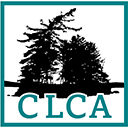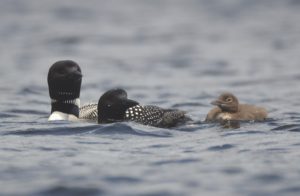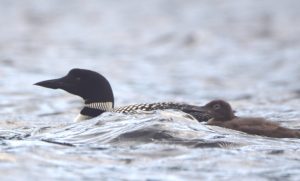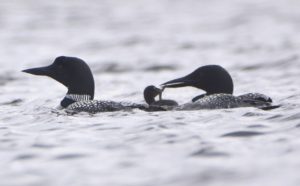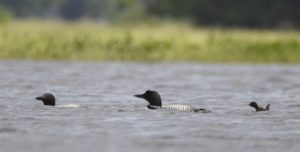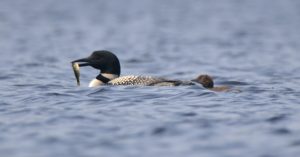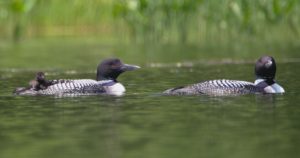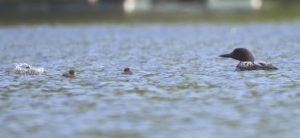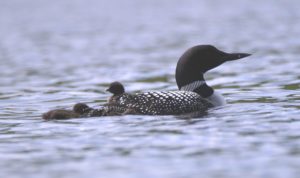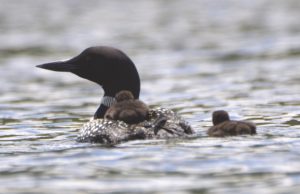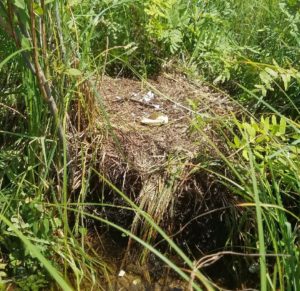
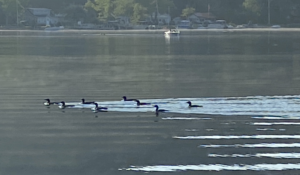 Flotilla of 8 Loons as seen on July 13, 2024.
Flotilla of 8 Loons as seen on July 13, 2024.
Residents of our lakes have always looked forward to the sighting of loons as the summer season begins, and well into fall, when they begin their migration journey. Since 2007, a volunteer team of residents has participated in the Adirondack Loon Census, under the auspices of the Biodiversity Research Institute and the Wildlife Conservation Society. The census is conducted on the third Saturday in July, when residents of the Adirondacks head out across lakes as observers to identify the number of adult loons, chicks and immature loons observed in a one hour period. This data is recorded and submitted to Dr. Nina Schoch for research and analysis into the loon breeding population. Critical issues include the levels of lead or mercury in their blood, and periodically loons are banded for study, including some on our lakes. In 2011, about 15 residents expanded the survey to include Canada Lake, Green Lake, Lily Lake and the Channel to gain a better overall picture of loons across our lakes. Here are the results:
| # Adult Loons | #Loon Chicks | #Immature Loons | Total | |
| 2011 | 10 | 1 | 0 | 11 |
| 2012 | 9 | 3 | 0 | 12 |
| 2013 | 7 | 2 | 0 | 9 |
| 2014 | 7 | 1 | 0 | 8 |
| 2015 | 7 | 2 | 0 | 9 |
| 2016 | 6 | 1 | 0 | 7 |
| 2017 | 6 | 1 | 0 | 7 |
| 2018 | 9 | 0 | 0 | 9 |
| 2019 | 8 | 4 | 0 | 12 |
| 2020 | 9 | 1 | 1 | 11 |
| 2022 | 7 | 2 | 0 | 9 |
| 2024 | 7 | 1 | 0 | 8 |
In addition, unproductive or destroyed nests which contained eggs have been found. All too frequently these are the result of human pressure where people on boats came too close and the loon abandoned the nest. Please resist the temptation of inspecting known loon nests.
Our very enthusiastic group of residents meets after the census to prepare a data sheet for submission and discuss the findings. We have decided to call ourselves “Loons of Canada Lake” and our hope is to provide education and awareness to all who enjoy this wonderful creature and our lakes.
Our Canada Lake association has been fully supportive of this effort, hosting an invited speaker to our annual meeting, providing a donation for signage at the boat launch, and pledging a commitment to protect our loon population. Here are some ways to ensure that loons will continue to thrive on our lakes;
- Protect shoreline habitat and leave natural vegetation around nesting habitat for cover
- Loons prefer to fish in shallow water close to shoreline for small fish and crayfish
- A Nursery area is ideal in a bay protected from wind and waves-Do Not Disturb!
- Stay away from nesting areas, the loons may swim away, hang over the nest, flap wings in the water, all signs of distress
- Vocalizing with a wail, tremolo or yodel can also be signs of distress. See the linked webpage for the different calls of loons.
- When motor boating, please observe no wake zones and speed limits. Kayaks and canoes should stay away from the shoreline to avoid flushing a loon off the nest
- Use non-lead fishing tackle and pick up abandoned fishing line
- Be aware of small chicks with parents on the lakes, they are hard to spot!
Photos by Randy Fredlund taken in July, 2019 of three loon families:
Useful Web pages dedicated to Loons:
http://www.briloon.org/adkloon Biodiversity Research Institute (BRI) has a major program to protect and conduct annual census of loons in the Adirondacks.
http://www.dec.ny.gov/animals/7173.html New York State Dept. of Environmental Conservation, includes HELP PROTECT LOONS! Sign post (printable) and other information.
http://www.wcs.org/conservation-challenges/wildlife-health/care-for-animals-in-the-wild/loons-of-the-adirondacks.aspx Wildlife Conservation Society has information about Loon Study by BRI.
http://www.allaboutbirds.org/guide/common_loon/id: The Common Loon, All About Birds, The Cornell Lab of Ornithology.
Audio: Hear the Calls of the Common Loon blog from the Syracuse Post Standard.
Thanks to Dave Graves and John Snyder for suggesting the above links.
